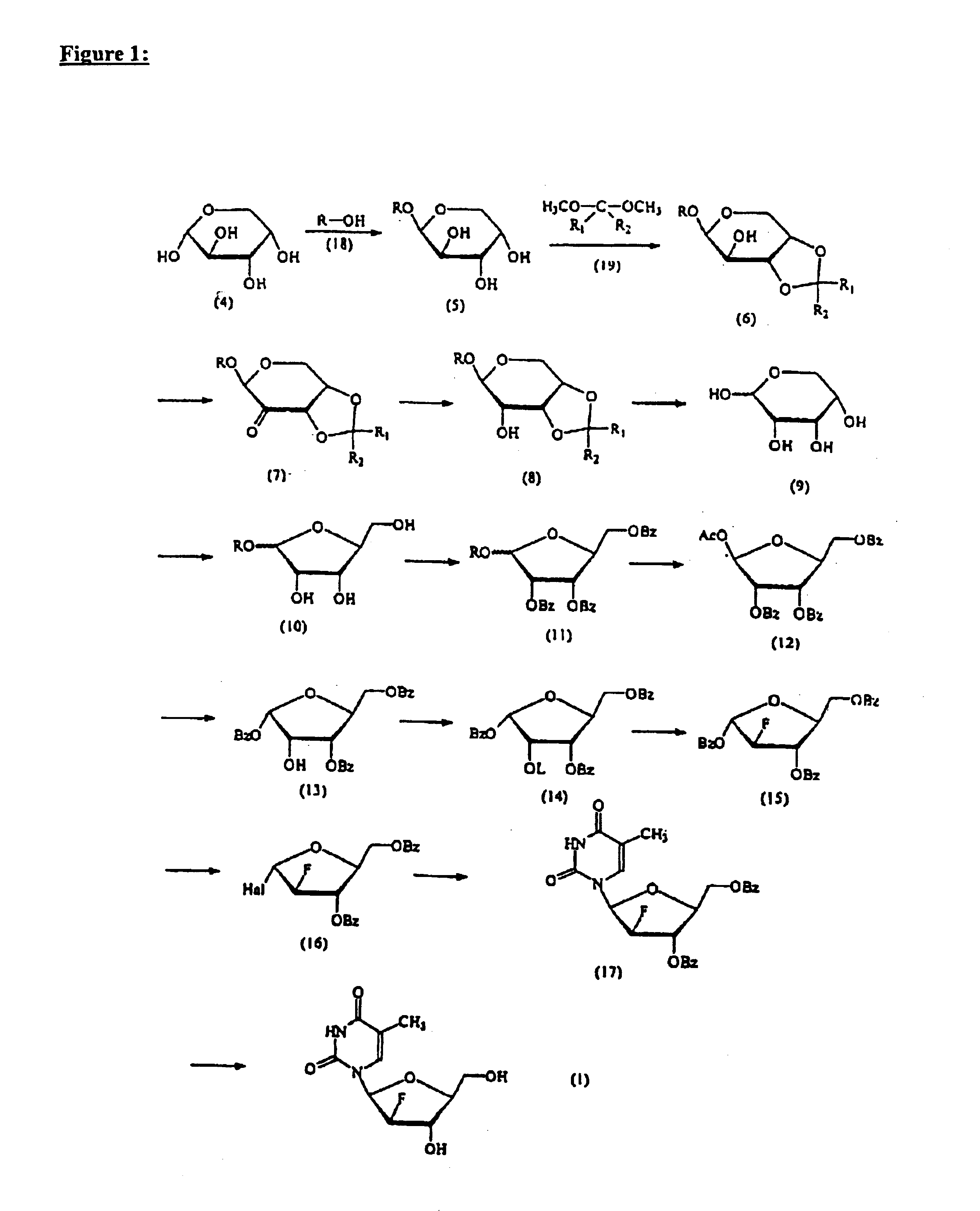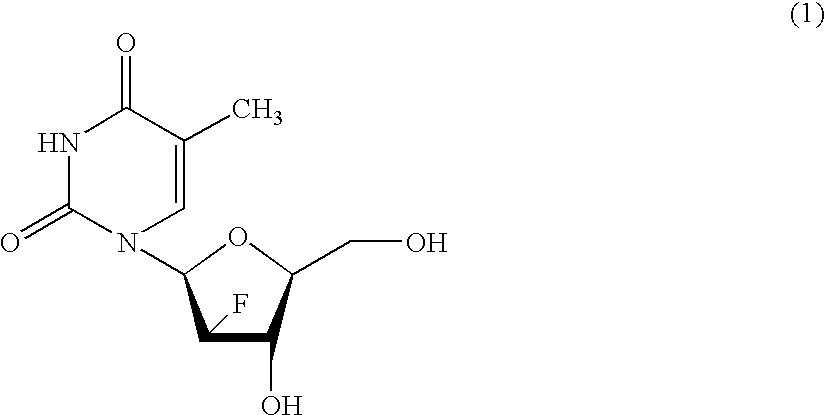Process for the preparation of 2'-fluoro-5-methyl-beta-L-arabino-furanosyluridine
a technology of arabinofuranosyluridine and process, which is applied in the field of process for the preparation of 2'-fluoro-5-methyl betalarabinofuranosyluridine, can solve the problem of high production cost of l-fmau
- Summary
- Abstract
- Description
- Claims
- Application Information
AI Technical Summary
Benefits of technology
Problems solved by technology
Method used
Image
Examples
example 2
Preparation of 1-O-benzyl-3,4-O-isopropylidene-β-L-riboside (8)
[0034]A mixture of 200 g (0.83 mole) of 1-O-benzyl-β-L-arabinoside (5), 240 ml (1.95 mole) of 2,2-dimethoxypropane and 4 g (0.02 mole) of p-TsOH H2O in 2000 ml of acetone was stirred at room temperature for 2 hours. The reaction mixture thereby obtained was neutralized with triethylamine and evaporated under reduced pressure to obtain the compound (6) in the form of a yellowish syrup, which was used for the next reaction without further purification.
[0035]To a mixture of the compound (6) and 240 g (0.63 mole) of pyridinium dichromate in 2000 ml of dichloromethane was added 240 ml (2.54 mole) of acetic anhydride at 0° C. and the mixture thereby obtained was then refluxed until the starting material disappeared (ca. 4 hours). At this time, the system was vented. The solvent was removed under reduced pressure until the mixture occupied one-third of its initial volume and the residue was poured into 1500 ml of ethyl acetate ...
example 3
Preparation of 1-O-acetyl-2,3,5-tri-O-benzoyl-β-L-ribofuranose (12)
[0038]201 g (0.717 mole) of the compound (8) dissolved in 11000 ml of 4% trifluoroacetic acid (CF3COOH) was refluxed until the starting material (ca. 1 hour) and the intermediate (1-O-benzyl derivative) had disappeared (ca. 4-8 hours). The reaction mixture was cooled to room temperature and washed with dichloromethane (4×500 ml) to remove benzyl alcohol. The aqueous layer thereby obtained was evaporated in vacuo and coevaporated with toluene (2×200 ml) to yield the compound (9) in the form of a yellowish syrup, which was completely dried under high vacuum to remove a trace amount of water.
[0039]The compound (9) was dissolved in 2000 ml of methanol and 15.8 g (0.43 mole) of HCl (gas) was bubbled into the mixture at room temperature. The mixture thereby obtained was stirred at room temperature for 2 hours, neutralized with 183 ml of pyridine and concentrated in vacuo at 30-35° C. to give a yellowish syrup, which was in...
example 4
Preparation of 1,3,5-tri-O-benzoyl-α-L-ribofuranose (13)
[0042]HCl (gas) was bubbled for 1.5 hours into a solution of 50 g (99.16 mole) of the compound (12) dissolved in 460 ml of anhydrous dichloromethane and 7.5 ml of acetyl chloride at 0° C. The resulting solution was kept in a refrigerator for 12 hours and then evaporated in vacuo. The residue was coevaporated with toluene (3×150 ml) at 45° C. and redissolved in 105 ml of acetonitrile. To this solution, 13 ml of water was added dropwise at 0° C. A white solid began to precipitate from the mixture after 30 minutes, after which the mixture was kept in a refrigerator for 2 hours to induce additional precipitation. After filtration of the resulting solid, the filter cake was carefully washed with cold diethylether to remove the reaction by-product 1-hydroxy-isomer, which is indistinguishable by TLC from the compound (13). The white solid thereby obtained was dissolved in ethyl acetate. The solution was washed with saturated sodium bi...
PUM
 Login to View More
Login to View More Abstract
Description
Claims
Application Information
 Login to View More
Login to View More - R&D
- Intellectual Property
- Life Sciences
- Materials
- Tech Scout
- Unparalleled Data Quality
- Higher Quality Content
- 60% Fewer Hallucinations
Browse by: Latest US Patents, China's latest patents, Technical Efficacy Thesaurus, Application Domain, Technology Topic, Popular Technical Reports.
© 2025 PatSnap. All rights reserved.Legal|Privacy policy|Modern Slavery Act Transparency Statement|Sitemap|About US| Contact US: help@patsnap.com



